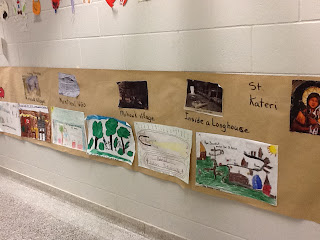We continue to work very hard in Math on patterns using T charts. What several children are finding difficult is that they are not sure of their addition facts. So when a pattern continues up by 3 or 4 or 5 etc... it can be challenging. How can we help?
Practicing the addition facts so that students can recall them quickly without counting on their fingers, is a huge advantage in many areas of Math. Begin with mastering doubles facts (6+6,7+7,8+8,9+9). Then move to near doubles: If I know 7+7 then 7+8 is one more. We have also learned the facts which add up to 10. The next step is to add 1,2,or 3. Then of course we will go to +4,+5. While many children in the class know their addition facts there are still several who are struggling. A few minutes spent every day will help. Soon we will move on to multiplication facts.
Ideas that might help? Flash card games, dice (throw 2 and add them or throw one and add the number you are working on). Brock's mom and I also found several interactive games at this website http://resources.woodlands-junior.kent.sch.uk/maths/interactive/ Frequent brief practice sessions are best : ))
Our Math Word wall is always there to help spell and reinforce Math Vocabulary. Now that we are also graphing our patterns we will learn words such as data, axes, vertical, horizontal (we used horizon in art as well) grid, titles, key, labels. What is that beast up on the wall? Our class mascot, Math Mouse, lives in the hole in the wall : ))

 In reading we are looking at non-fiction. We have checked many text features that help us understand what we are reading such as photos, captions, charts, labelled diagrams and text boxes. Now we are beginning to focus more on making connections with non-fiction.
In reading we are looking at non-fiction. We have checked many text features that help us understand what we are reading such as photos, captions, charts, labelled diagrams and text boxes. Now we are beginning to focus more on making connections with non-fiction. We read a text called The Terrific Triangle. Noah said he connected with the fact that there are shapes in nature such as a circle, or rectangle and why are things the shapes they are? Wyatt G noticed that these strong shapes such as a square and a triangle are used in building our houses and who makes sure these shapes are strong enough for our houses to stay up? Victoria thought that Science seemed to be connected with shapes and there seemed to be rules to follow. This text and the one we read today on building igloos will introduce our next Science theme. Teacher trick #352 in how to cover the curriculum.... integrate! Above is a photo showing students testing rectangles and triangles after reading a procedural text .....
This is a photo of the thoughtful writing your children did for Thanksgiving as part of our religion program! Same teacher trick:combine reading The Secret of Giving Thanks with writing, religion and covering our school's October value "Gratitude".
Our Science posters are completed and students will show them to the class. They will share with their classmates how forces of nature happen and how these forces can affect us. In addition to exploring the Science of forces, students learned how to present a well laid out poster and how to make and print a title with our netbooks. Test on forces this coming Monday, Dec.3.
 |
| In Religion as part of All Saints Day, we learned about St. Kateri and made this poster to show the story of her life. |
 |
| Kateri was bullied because of her beliefs. She was finally able to go from Upper New York State to Montreal where she could be with other Christians. |
 |
| Kateri worked with the sick and the elderly. She was beloved by her community in Montreal. |
 |
| Gorgeous paintings! Our class takes their art very seriously and have enjoyed working with paint. |
Almost ready to video tape our bullying awareness skits. We saw a great live presentation last week that will help us focus our skits on what role bystanders can play. A bystander can be a cheerleader who encourages the bully, a watcher or hider who doesn't know what to do. THEN along comes the UPSTANDER !! who is the superhero who gets help or steps in to help (if its safe).
The link below will bring you to a bullying awareness song/video that we watched: True colours
http://www.youtube.com/watch?v=OzfYL51e3HI Click on the link and another prompt will bring you to the youtube video.





















